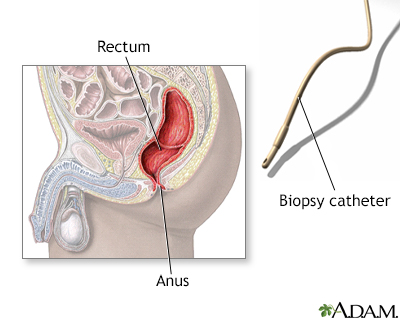Rectal biopsy
Biopsy - rectum; Rectal bleeding - biopsy; Rectal polyps - biopsy; Amyloidosis - rectal biopsy; Crohn disease - rectal biopsy; Colorectal cancer - biopsy; Hirschsprung disease - rectal biopsy
A rectal biopsy is a procedure to remove a small piece of tissue from the rectum for examination.
Images

How the Test is Performed
A rectal biopsy is usually part of anoscopy or sigmoidoscopy. These are procedures to view inside the rectum.
A digital rectal exam is done first. Then, a lubricated instrument (anoscope or sigmoidoscope) is placed into the rectum. You will feel mild discomfort when this is done.
A biopsy can be taken through either of these instruments.
How to Prepare for the Test
You may get a laxative, enema, or other preparation before the biopsy so that you can completely empty your bowel. This will allow the health care provider a clear view of the rectum.
How the Test will Feel
There will be some discomfort during the procedure. You may feel like you need to have a bowel movement. You may feel cramping or mild discomfort as the instrument is placed into the rectal area. You may feel a pinch when a biopsy is taken.
Why the Test is Performed
A rectal biopsy is used to determine the cause of abnormal growths found during anoscopy, sigmoidoscopy, or other tests. It can also be used to confirm the diagnosis of amyloidosis (rare disorder in which abnormal proteins build up in tissues and organs).
Normal Results
The anus and rectum appear normal in size, color, and shape. There should be no evidence of:
- Bleeding
- Polyps (growth on the lining of the anus)
- Hemorrhoids (swollen veins in the anus or lower part of the rectum)
- Other abnormalities
No problems are seen when the biopsy tissue is examined under a microscope.
What Abnormal Results Mean
This test is a common way to determine the specific causes of abnormal conditions of the rectum, such as:
- Abscesses (collection of pus in the area of the anus and rectum)
- Colorectal polyps
- Infection
- Inflammation
- Tumors
- Amyloidosis
- Crohn disease (inflammation of the digestive tract)
- Hirschsprung disease in infants (blockage of the large intestine)
- Ulcerative colitis (inflammation of the lining of the large intestine and rectum)
Risks
Risks of a rectal biopsy include bleeding.
Related Information
Primary amyloidosisColitis
Colorectal polyps
Abscess
Hirschsprung disease
Ulcerative colitis
Crohn disease
References
Downs JM, Kulow B. Anal diseases. In: Feldman M, Friedman LS, Brandt LJ, eds. Sleisenger and Fordtran's Gastrointestinal and Liver Disease. 11th ed. Philadelphia, PA: Elsevier; 2021:chap 129.
Gibson JA, Odze RD. Tissue sampling, specimen handling, and laboratory processing. In: Chandrasekhara V, Elmunzer J, Khashab MA, Muthusamy VR, eds. Clinical Gastrointestinal Endoscopy. 3rd ed. Philadelphia, PA: Elsevier; 2019:chap 5.
BACK TO TOPReview Date: 9/30/2024
Reviewed By: Jonas DeMuro, MD, Diplomate of the American Board of Surgery with added Qualifications in Surgical Critical Care, Assistant Professor of Surgery, Renaissance School of Medicine, Stony Brook, NY. Review provided by VeriMed Healthcare Network. Also reviewed by David C. Dugdale, MD, Medical Director, Brenda Conaway, Editorial Director, and the A.D.A.M. Editorial team.

Health Content Provider
06/01/2025
|
A.D.A.M., Inc. is accredited by URAC, for Health Content Provider (www.urac.org). URAC's accreditation program is an independent audit to verify that A.D.A.M. follows rigorous standards of quality and accountability. A.D.A.M. is among the first to achieve this important distinction for online health information and services. Learn more about A.D.A.M.'s editorial policy, editorial process and privacy policy. A.D.A.M. is also a founding member of Hi-Ethics. This site complied with the HONcode standard for trustworthy health information from 1995 to 2022, after which HON (Health On the Net, a not-for-profit organization that promoted transparent and reliable health information online) was discontinued. |
The information provided herein should not be used during any medical emergency or for the diagnosis or treatment of any medical condition. A licensed medical professional should be consulted for diagnosis and treatment of any and all medical conditions. Links to other sites are provided for information only -- they do not constitute endorsements of those other sites. © 1997- 2025 A.D.A.M., a business unit of Ebix, Inc. Any duplication or distribution of the information contained herein is strictly prohibited.
